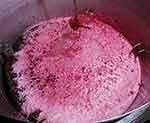Take a look at the results of an absolutely fascinating study of the ambient yeasts involved in making wine at Michael Brajkovich's Kumeu River winery outside Auckland.
This report published today in New Zealand under the rather jingoistic headline 'Unique New Zealand Yeasts Discovered', suggests that the great discovery is further proof of New Zealand's superiority. But I would humbly submit that even more interesting than this is what the researchers established about how yeasts travel.
They counted over 100 different yeast strains in the yeast found in a Mate's Vineyard Chardonnay ferment at Kumeu River winery (which has been dependent on wild rather than cultured yeast for over 20 years), many of them highly individual.
'The Kumeu River yeast population was surprisingly diverse and distinctive, and we wanted to know where the strains came from', said Dr Mat Goddard, who led the research. Further genetic analyses indicated that the Kumeu population comprised six different but interbreeding groups. 'None was related to commercial yeast strains, so they couldn't have "escaped" from a local winery. Nor could we detect any Saccharomyces cerevisiae in the winery before harvest, so the yeast must have come from an outside source.'
This led the researchers to examine the yeast in the soil, bark and flowers of a Matua Valley vineyard (next to native bush), where they found some correlation, and eventually established that honey bees must have transported the yeast between wineries.
Perhaps even more revealing was the discovery that another group of yeast strains had been introduced via a new oak barrel imported from France, thereby proving that humans can distribute yeast by accident.
The full report is published online (and will follow in print, subscription needed for both) in the prestigious journal Environmental Microbiology and should help us understand something of the complex relationship, or not, between yeast and terroir.

